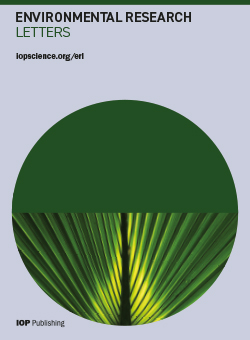Increasing exposure of global croplands productivity to growing season heatwaves under climate warming
IF 5.6
2区 环境科学与生态学
Q1 ENVIRONMENTAL SCIENCES
引用次数: 0
Abstract
Growing season heatwaves that occur simultaneously over global croplands can negatively impact global food baskets. The long-term changes of growing season heatwaves, as well as their impacts on croplands productivity, are crucial to food security, but remain unclear. Here, we investigated changes in the frequency, intensity and magnitude of growing season heatwaves from the past to the future over the global croplands, based on observations and Coupled Model Intercomparison Project Phase 6 models. We introduced an index, gross primary productivity (GPP) exposure, as a proxy of the overall impact of heatwaves on cropland productivity. The results show that the frequency and intensity of growing season heatwaves have increased since 1950 and will continue throughout the 21st century. The increase of the annual accumulated magnitude of growing season heatwaves in the future is mainly contributed by the increase of heatwave frequency. This leads to a global-scale increase in the GPP exposure to growing season heatwaves, with Asia, North America, and Europe being the most affected. The continued increase in GPP exposure is dominated by increases in heatwaves rather than GPP itself. Under the lower emission scenario SSP1-2.6, the global cropland GPP exposure will reduce by 86.11% and 330.47% relative to that under SSP2-4.5 and SSP5-8.5 scenarios, respectively, by the end of 21st century. Our results provide crucial insights into potential impacts of heatwaves on cropland productivity and hence food security.在气候变暖的情况下,全球耕地生产力越来越容易受到生长季节热浪的影响
在全球耕地上同时出现的生长季热浪会对全球菜篮子产生负面影响。生长季热浪的长期变化及其对耕地生产力的影响对粮食安全至关重要,但目前仍不清楚。在此,我们基于观测数据和耦合模式相互比较项目第六阶段模型,研究了从过去到未来全球耕地生长季热浪的频率、强度和规模的变化。我们引入了总初级生产力(GPP)暴露指数,作为热浪对耕地生产力总体影响的替代指标。结果表明,自 1950 年以来,生长季热浪的频率和强度都在增加,并将持续整个 21 世纪。未来生长季热浪年累积量的增加主要是由于热浪频率的增加。这导致全球范围内全球升温潜能值受生长季热浪影响的程度增加,其中亚洲、北美和欧洲受到的影响最大。全球升温潜能值持续增加的主要原因是热浪的增加,而不是全球升温潜能值本身。在较低排放情景 SSP1-2.6 下,到 21 世纪末,全球耕地 GPP 暴露将比 SSP2-4.5 和 SSP5-8.5 情景下分别减少 86.11% 和 330.47%。我们的研究结果为了解热浪对耕地生产力以及粮食安全的潜在影响提供了重要启示。
本文章由计算机程序翻译,如有差异,请以英文原文为准。
求助全文
约1分钟内获得全文
求助全文
来源期刊

Environmental Research Letters
环境科学-环境科学
CiteScore
11.90
自引率
4.50%
发文量
763
审稿时长
4.3 months
期刊介绍:
Environmental Research Letters (ERL) is a high-impact, open-access journal intended to be the meeting place of the research and policy communities concerned with environmental change and management.
The journal''s coverage reflects the increasingly interdisciplinary nature of environmental science, recognizing the wide-ranging contributions to the development of methods, tools and evaluation strategies relevant to the field. Submissions from across all components of the Earth system, i.e. land, atmosphere, cryosphere, biosphere and hydrosphere, and exchanges between these components are welcome.
 求助内容:
求助内容: 应助结果提醒方式:
应助结果提醒方式:


